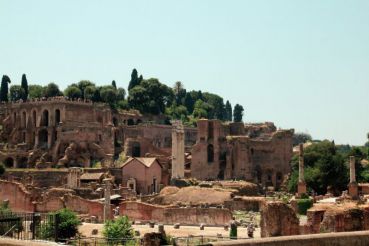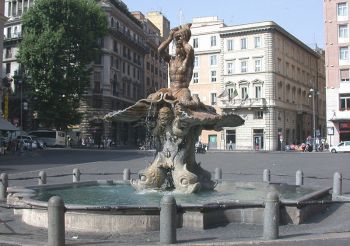Roman Forum, Rome

The Roman Forum (Foro Romano) played an important role in the political and economic life of the city in the era of the prosperity of ancient Rome. One of the most famous sights of the capital of Italy is situated between three hills: Esquiline, Capitoline, Palatine. For many years various structures were built in the valley between the hills. Ruins of many ancient buildings today constitute one huge archaeological complex under the open sky. All of its exhibits emphasize the former greatness of the Eternal City.
Not only tourists visit the Roman Forum. Many directors choose this place for the filming of their films.
History of the Roman Forum
Once upon a time, more precisely until the 8th century BC, it was a swamp area among the hills, which was used as a cemetery. A reliable drainage system built during the reign of the fifth king of Ancient Rome, Tarquin the Elder, allowed to drain these places.
The central square played an important role in the life of the ancient city. Initially, there was a market trade, followed by meetings of the Romans and the Senate. The years passed and the rulers changed. Together with them, the forum also changed. During the reign of Augustus, it reached the peak of his development. The Foro Romano became the most important focus of the social, political and religious life of Rome.
With the emergence of Christianity, churches were built in the forum. After the collapse of the Roman Empire, for a long time the main square was once again in desolation. In the Middle Ages, cattle was grazing among ancient ruins, from which the second name of the ancient center appeared – Campo Vaccino (cattle field). Local residents dismantled the grandiose buildings for building material. This continued until the 19th century, until archaeologists and restorers took up the preservation of evidence of the power of ancient Rome.
The period of Benito Mussolini's rule was a dark period for the archaeological complex. At this time excavations were not very sparing, so many valuable exhibits were lost for good.
Sights of Forum
Today, excavations of the ancient forum are one of the main tourist sites of Rome. Among the surviving reminders of the great past today you can see:
- Obelisk “Black stone” or Lapis Niger, which marks the place of the death of Romulus.
- Altar Vulcanal is a sacred structure in honor of the god of the fire of Vulcan, founded, according to legend, by Romulus himself.
- The foundation of the Venus Cloacina Sanctuary, or Venus the Purifier. The legend says that a rite of purification of the Romans was held in the temple after the Sabine war.
- The Temple of Venus and Roma – the largest religious structure of Ancient Rome, built in 135 AD.
- Temple of Vesta. The ancient temple of Vesta, the goddess of the family fire, is located near the temple of Caesar.
- The temple of Saturn, built around 489 BC. Until now, columns of the Ionic order have been preserved.
- Basilica of Maxentius and Constantine – the largest construction forum, its construction was completed in 312 AD.
- The temple of Antoninus and Faustina was built by order of Emperor Antoninus Pius in honor of his late wife Faustina.
- Temple of Caesar. It was consecrated in 29 BC. According to the images on ancient coins, the image of the temple was installed.
- Temple of Vespasian and Titus is an ancient temple of 79 AD, dedicated to two emperors. Up to now, only three 15-meter columns have survived.
- Temple of the Dioscuri is dedicated to the sons of the ancient Roman god Jupiter. It was built in 484 BC. Three of its surviving columns are called "three sisters".
- The Arch of Titus is located on the Sacred Road, it was built in 82 AD in honor of the capture of Jerusalem.
- The city's navel (Umbilicus urbis) – the ruins of the temple, which in ancient times symbolized the center of the Roman state.
- The arch of Septimius Severus is another preserved arch on the Sacred Road, built in 205 AD.
- The Sacred Road, or Via Sacra. In the Ancient Roman era, all the main processions passed on this road that, it was the main trade route. It was founded in the 5th century under the rule of the Emperor Nero.
How to get there
The Roman Forum is located at the intersection of Via Cavour and Via dei Fori Imperiali. You can get there by metro to Colosseo station, by tram № 3, or by one of the buses № 3, 60, 75, 84, 85, 87, 117, 175, 271, 571, 810, 850 to Colosseo stop.
Opening hours:
- From 2 January to 15 February: 8:30–16:30.
- From February 16 to March 15: 8:30–17:00.
- From March 16 to the last Saturday in March: 8:30–17:30.
- From the last Sunday in March to August 31: 8:30–19:15.
- From 1 to 30 September: 8:30–19:00.
- From 1 October to the last Saturday in October: 8:30–18:30.
- From the last Sunday in October to December 31: 8:30–16:30.
The ticket office closes an hour before the closing of the Forum. Days off: December 25 and January 1.
Entrance fee: 12 euros. Admission is free on the first Sunday of the month. For an additional fee, you can purchase an audio guide or a tour guide. Visiting the Forum during the organized excursion, of course, will be more informative.
It is worth noting that a visit to the Roman Forum, the Colosseum, which is located very close by, and the Palatine, is carried out on a single ticket. You can buy it at the cashier of any of these objects. The ticket is valid for 2 days. Data of January 2018.




